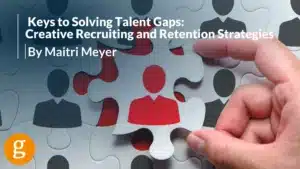Keys to Solving Talent Gaps: Creative Recruiting and Retention Strategies
Maitri Meyer | Hiring Advice, Leadership, Opinion | January 8, 2025

In 2024, the global talent shortage was a persistent and pressing issue for businesses. Companies faced greater challenges than ever in finding qualified candidates, especially in specialized fields. Unfortunately, this trend is expected to continue and perhaps intensify in 2025.
Here’s a look at the current state of the talent shortage challenge, factors contributing to this ongoing issue, and three effective solutions for attracting and retaining top talent in 2025 and beyond.
Current state and contributing factors
1. Global talent shortage
According to ManpowerGroup’s 2024 Talent Shortage Survey, “75% of employers report difficulty filling positions.” This marks a dramatic increase from previous years (it was 40% in 2017). The talent shortage is particularly acute in roles requiring specialized expertise, such as IT, engineering, and healthcare.
Despite increasing demand for talent in these and other areas, companies are struggling to find qualified potential candidates. And as industries become more specialized and technology continues to advance, businesses are under mounting pressure to fill critical positions to maintain stability and growth.
2. Aging workforce
The Baby Boomer generation continues to retire at a rapid pace, with 11,200 Americans set to turn 65 every day through 2027. This trend, which is expected to continue well into the mid-2030s, is leaving a significant gap in leadership and specialized roles across industries.
As Baby Boomers exit the workforce, their experience and expertise are hard to replace, and companies are facing immense pressure to fill senior positions. Compounding this challenge is a slowdown in the number of younger workers entering the workforce.
3. Generational gaps in leadership
The Gen X generation, which traditionally fills many mid-level leadership roles, is significantly smaller in size (approximately 65 million Americans) compared to the Baby Boomer generation (about 76 million).
A shortage of experienced leaders is contributing to a leadership vacuum that hinders organizations’ ability to adapt, innovate, and navigate complex business landscapes. Companies are struggling to develop the next generation of leaders as this gap becomes more pronounced in mid-level, senior, and executive roles.
4. Lack of succession planning
Succession planning remains a major challenge for many businesses, particularly smaller ones. A 2023 study found that approximately 40% of organizations have not formalized a leadership succession plan. This oversight is exacerbating talent and skills gaps, especially as Baby Boomers retire. Additionally, many companies are failing to invest enough in developing high-potential employees, further delaying their ability to fill critical leadership and technical positions.
5. Lingering post-pandemic caution
The COVID-19 pandemic created significant economic uncertainty, leading many businesses to adopt a more cautious approach to hiring. Temporary layoffs, furloughs, and terminations during the pandemic left companies hesitant in committing to full-time hires in our post-pandemic world, particularly in roles where the return on investment (ROI) is unclear. This cautious hiring mentality is contributing to the ongoing talent shortage, as businesses continue to weigh the costs of full-time hires versus more flexible staffing solutions.
6. Resistance to providing visa sponsorship for foreign workers
As talent recruiters, we receive qualified foreign applicants who are recent graduates of U.S. colleges and universities and want to remain in the United States for their first career positions. Oftentimes, these candidates already have optional practical training (OTP) visas that allow them to work for three years in the United States to expand on their higher education studies. However, many employers are still hesitant to hire from this skilled talent pool.
3 effective solutions to overcome the talent shortage
Businesses can take proactive steps to address and overcome talent shortages. Here are three talent acquisition strategies that companies are successfully using to tackle talent gaps.
1. Partner with an experienced recruiter to find top talent
As the labor market tightens and competition for talent intensifies, recruiting new employees is more difficult. Despite employers’ best efforts, LinkedIn reports that nearly 50% of positions still take longer than expected to fill, resulting in missed opportunities and slow business growth.
Businesses need to be creative in their recruitment approaches to meet goals and market demand. To make this happen, companies are heavily investing in more effective recruiting strategies, such as partnering with outside recruiters to diversify their talent pipelines and gain access to new sources of talent. Inviting a professional recruiting agency to partner in creating a strategy based on what they see in the marketplace is helping hiring companies leap ahead of the competition.
2. Develop, upskill, and retain your current talent
The cost of employee turnover is staggering, especially in specialized roles. In 2024, the average cost of turnover for a company was estimated to be around 33% of an employee’s annual salary, including recruitment, training, and lost productivity.
As businesses continue to face a tight labor market, investing in employee retention is more critical than ever. One of the most effective initiatives to retain employees is offering continuous learning and training programs and professional development opportunities. Companies are shifting from traditional in-person training to hybrid models, offering virtual learning opportunities, mentorship programs, and personalized career development plans.
Further, as employees continue to seek more flexible work arrangements, offering growth and development opportunities is an excellent incentive that fosters employee satisfaction and the retention of top talent. This investment is far more cost-efficient than the cost of employee turnover, and it also helps to build a stronger company culture and employer brand.
3. Outsource certain talent requirements
Outsourcing is becoming a go-to solution for many businesses struggling to fill talent gaps. With the rise of remote work and the growing freelance economy, companies are increasingly turning to independent contractors, consultants, and other external experts to address short-term and specialized needs.
This approach allows companies to access high-level talent and necessary skillsets without the long-term commitment and overhead costs associated with full-time employees. Platforms like Upwork and Fiverr have seen a 40% increase in demand for specialized freelance professionals, particularly in fields such as marketing, IT, and data analytics. By outsourcing certain functions, businesses can remain agile and maintain access to critical expertise without the challenges, time, and costs of traditional talent recruitment and hiring processes.
Get flexible, innovative, and committed to building a resilient workforce for the future
The ongoing talent shortage is a multifaceted issue that is unlikely to resolve on its own. For businesses looking to stay competitive, it’s crucial to stay ahead of the talent curve and adapt to today’s ever-changing hiring landscape.
By implementing proactive recruitment strategies, investing in employee retention and development, and leveraging outsourcing, companies can more effectively navigate talent shortages in 2025 and beyond.
Get in touch with me and let’s find leaders and team members with the competencies you need. My name is Maitri (pronounced “my tree”) Meyer. I am a recruiting partner with Goodwin Recruiting and welcome the opportunity to assist in your search for professionals who can not only help lead your organization forward but are also ideal fits for your company culture.
Share This Article












































